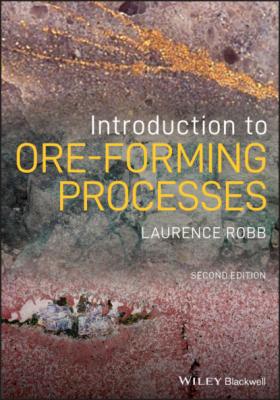Introduction to Ore-Forming Processes. Laurence Robb
Читать онлайн.| Название | Introduction to Ore-Forming Processes |
|---|---|
| Автор произведения | Laurence Robb |
| Жанр | География |
| Серия | |
| Издательство | География |
| Год выпуска | 0 |
| isbn | 9781119232384 |
Table of Contents
1 Cover
4 Introduction: Mineral Resources Introduction and Aims A Classification Scheme for Ore Deposits What Makes a Viable Mineral Deposit? Some Useful Definitions and Compilations Natural Resources, Sustainability, and the Environment Summary Further Reading
5 Part I: Igneous Processes 1 Igneous Ore‐Forming Processes 1.1 Introduction 1.2 Magmas and Metallogeny 1.3 Why Are Some Magmas More Fertile than Others? The “Inheritance Factor” 1.4 Partial Melting and Crystal Fractionation as Ore‐Forming Processes 1.5 Liquid Immiscibility as an Ore‐Forming Process 1.6 A More Detailed Consideration of Mineralization Processes in Mafic Magmas 1.7 A Model for Mineralization in Layered Mafic Intrusions 1.8 Summary Further Reading 2 Magmatic‐Hydrothermal Ore‐Forming Processes 2.1 Introduction 2.2 Some Physical and Chemical Properties of Water 2.3 Formation of a Magmatic Aqueous Phase 2.4 The Composition and Characteristics of Magmatic‐ Hydrothermal Solutions 2.5 A Note on Pegmatites and Their Significance to Granite‐ Related Ore‐Forming Processes 2.6 Fluid–Melt Trace Element Partitioning 2.7 Water Content and Depth of Emplacement of Granites – Relationships to Ore‐Forming Processes 2.8 Models for the Formation of Porphyry‐Type Cu, Mo, and W Deposits 2.9 Near‐Surface Magmatic‐Hydrothermal Processes – The “Epithermal” Family of Au–Ag–(Cu) Deposits 2.10 Skarn Deposits 2.11 Fluid Flow in and Around Granite Plutons 2.12 The Role of Hydrothermal Fluids in Mineralized Mafic Rocks 2.13 Summary Further Reading
6 Part II: Hydrothermal Processes 3 Hydrothermal Ore‐Forming Processes 3.1 Introduction 3.2 Other Fluids in the Earth's Crust and Their Origins 3.3 The Movement of Hydrothermal Fluids in the Earth's Crust 3.4 Additional Factors Affecting Metal Solubility 3.5 Precipitation Mechanisms for Metals in Solution 3.6 Fluid–Rock Interaction – Introduction to Hydrothermal Alteration 3.7 Metal Zoning and Paragenetic Sequence 3.8 Modern Analogues of Ore‐Forming Processes – The VMS–SEDEX Continuum 3.9 Mineral Deposits Associated with Aqueo‐Carbonic Metamorphic Fluids 3.10 Ore Deposits Associated with Basinal Fluids 3.11 Ore Deposits Associated with Near Surface Meteoric Fluids (Groundwater) 3.12 Summary Further Reading
7 Part III: Sedimentary/Surficial Processes 4 Surficial and Supergene Ore‐Forming Processes 4.1 Introduction 4.2 Principles of Chemical Weathering 4.3 Lateritic Deposits 4.4 Clay Deposits 4.5 Calcrete‐Hosted Deposits 4.6 Supergene Enrichment of Cu and Other Metals in the Near Surface Environment 4.7 Summary Further Reading 5 Sedimentary Ore‐Forming Processes 5.1 Introduction 5.2 Clastic Sedimentation and Heavy Mineral Concentration – Placer Deposits 5.3
